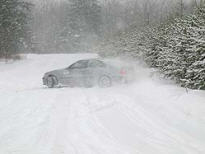Driver Training In Bad Weather
In Canada and northern parts of a lot of countries we have to deal with winter driving commonly called bad weather.
The question is: If you are conducting a training course that is weeks long, and a day of bad weather appears, do you take inexperienced drivers out on the road in poor conditions to drive? Or, do you stay safely inside and cancel road training for the day? These items may help you the instructor decide.
What Is Bad Weather

What is bad weather? If a person from Florida had to drive on snow covered roads, that person may consider that bad weather. To a person living in a northern climate that is standard. Bad weather may be freezing rain, low visibility or a foot of snow. So, it comes down to what you are used to.
For this topic I am going to consider extreme freezing rain as one of the bad conditions, so bad you can hardly stand up. Blowing snow with varying visibility and slippery roads would be another. Ice pellets that has turned to hard packed ice with snow on top is another common one. It is likely under these conditions traffic won't be moving very quickly, and hazards of sliding or parked vehicles exist everywhere.
Two Trains of Thought For Driver Training In Bad Weather
Remember, we are dealing with large vehicles, buses or large trucks. Car drivers often have a choice and can choose whether they need to drive or not. Buses for example, usually have to continue no matter what, because the people they brought to work earlier in the day have to get back home somehow.
Thought #1:
Get off the road. There is absolutely no need for a training vehicle to be out under those conditions adding to the hazards. With inexperienced people at the wheel the chances of getting involved in a collision is increased a thousand times or more. The training vehicle will likely be a hinderance to other drivers because they are not capable of dealing with the situations fast enough.
Thought #2:
These drivers are being trained to drive at all times in all kinds of situations, weather included. It is good practise to be able to do it without the traveling public on board and under the guidance of an instructor. Better to experience a skid, loss of traction or a sliding stop prior to having a loaded vehicle later on.
Answer
This one doesn't have an easy answer. In fact the answer will likely be different for each storm or occurance. The instructor is responsible to make the decision as to what is best.
Sometimes you will decide to go out on the road for the real time experience. Depending on how far advanced your students are, it can be a valuable experience for later driving when they are on their own.
Other times you will stay safely inside your building doing extra classroom time. Road time can be made up later. There is a point where the on road situation during a storm becomes so severe that a large vehicle is just a target for other drivers who don't adjust to conditions. That would mean collision reports and time wasted anyway. During these severe conditions if you go out on the road you may not accomplish much due to stopped or slow traffic flow.
How Do You Decide Whether To Stay Put or Head Out On The Road During A Storm
- Get information from you other company drivers that are or were out on the road as to the conditions.
- Contact operations supervisors to see how busy they have been with traffic related incidents.
- Contact your dispatcher, controller or others that keep your operation running smoothly. (If they are too busy to talk to you, then that is your answer.)
- Contact your maintenance department to see how many tow jobs are on the go, or how busy they have been. How many stuck vehicle calls do they have in waiting?
- You may elect to take a short test drive yourself, with your students to get a sense of what it is really like out there.
There are many sources of information to help you decide whether to go or stay. These will get you started in the right direction. For in training it is up to you to make the decision, the correct one.
